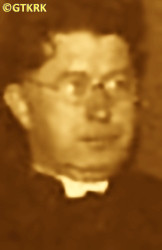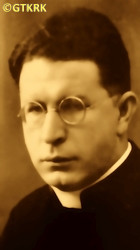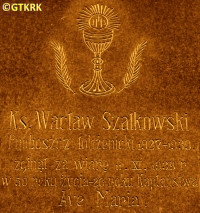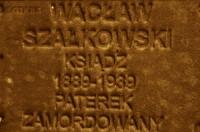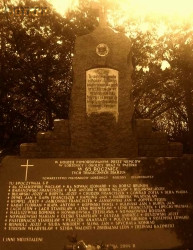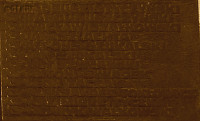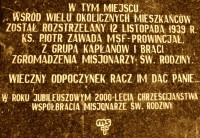Roman Catholic
St Sigismund parish
05-507 Słomczyn
85 Wiślana Str.
Konstancin deanery
Warsaw archdiocese, Poland
full list:
displayClick to display full list

searchClick to search full list by categories
wyświetlKliknij by wyświetlić pełną listę po polsku

szukajKliknij by przeszukać listę wg kategorii po polsku

Martyrology of the clergy — Poland
XX century (1914 – 1989)
personal data
religious status
Servant of God
surname
SZAŁKOWSKI
forename(s)
Vaclav Michael (pl. Wacław Michał)
function
diocesan priest
creed
Latin (Roman Catholic) Church RCmore on
en.wikipedia.org
[access: 2014.09.21]
diocese / province
Gniezno and Poznań archdiocese (aeque principaliter)more on
www.archpoznan.pl
[access: 2012.11.23]
date and place
of death
11.11.1939

Paterektoday: Nakło nad Notecią gm., Nakło nad Notecią pov., Kuyavia‐Pomerania voiv., Poland
more on
en.wikipedia.org
[access: 2021.12.18]
alt. dates and places
of death
12.11.1939
details of death
After the German and Russian invasion of Poland in 09.1939 and the start of World War II, after start of German occupation, arrested by the Germans on 26.10.1939.
Held in the VSH Lobsens detention center in Łobżenica, run by the paramilitary, genocidal organization Germ. Volksdeutscher Selbstschutz (Eng. Ethnic German Self‐Defense), whose members were Germ. Volksdeutsche (Eng. Ethnic Germans), i.e. treacherous representatives of the German minority in Poland.
Tortured.
Next, on 09.11.1939, taken to the VSH Gorka detention center in Górka Klasztorna, c. 2 km from Łobżenica, right on the pre‐war border with Germany, organized in the monastery of the Missionaries of the Holy Family MSF.
From there — on a truck, with hands tied behind back with barbed wire — driven towards Nakło.
There the group from VSH Gorka was prob. added to c. 100 people from Nakło, detained that day, i.e. 11.11.1939, Poland's Independence Day, during an operation the Germans called a „cleansing operation”, and all were taken to the execution site.
The genocidal murders — in a valley next to a dirt road, on the site of a former gravel/sand pit, c. 1.5 km from the small village of Paterek, located on the left bank of the Noteć River and c. 4.5 km from the center of the town of Nakło on the right bank of the Noteć — were carried out, as part of the Germ. «Intelligenzaktion» (Eng. Intelligence Action), i.e. the extermination of the Polish intelligentsia and the leadership classes of Pomerania, by units of the Germ. Volksdeutscher Selbstschutz from Nakło and the surrounding area.
The selection of victims from Nakło and the surrounding area — from among those arrested on the basis of the so‐called Germ. Sonderfahndungsliste (Eng. Special Wanted List), i.e. a proscription list of names of „enemies of the Reich”, prepared before the German aggression, but mainly based on denunciations from local Germ. Volksdeutsche, was compiled by a self‐appointed commission consisting of representatives of the Germ. Volksdeutscher Selbstschutz from Nakło.
The condemned were brought, mainly at night, from Nakło‐from the local municipal jail and the basements of the local high school, where they were beaten and tortured‐in cars, over a bridge over the Noteć River. The last section of the journey, beyond the village of Paterek, they were prob. driven on foot, with their hands tied behind their backs, tied together.
Members of the Germ. Volksdeutscher Selbstschutz shot the victims over dug holes, and brutally finished off the wounded with pistol shots, rifle butts, shovel blows, etc. — during the exhumation, it was discovered that every fourth skull was shattered.
The holes were then filled in.
In total, in a series of mass executions, from 04.10.1939 to 24.11.1939, the Germans murdered over 218 people in Paterek. Among them were 18 children, including a 4‐year‐old boy; there were large families. The oldest person was 70.
There were also 48 priests and monks (including two nuns) brought from VSH Gorka.
In 07.1945, after the end of military operations of World War II, bodies were exhumed from 13 mass graves.
cause of death
mass murder
perpetrators
Germans
sites and events
PaterekClick to display the description, VSH GorkaClick to display the description, VSH LobsensClick to display the description, «Intelligenzaktion»Click to display the description, Reichsgau Danzig‐WestpreußenClick to display the description, Ribbentrop‐MolotovClick to display the description, Pius XI's encyclicalsClick to display the description
date and place
of birth
29.09.1889Birth certification on:
www.genealogiawarchiwach.pl
[access: 2025.09.08]

Inowrocławtoday: Inowrocław gm., Inowrocław pov., Kuyavia‐Pomerania voiv., Poland
more on
en.wikipedia.org
[access: 2021.07.18]
parents
SZAŁKOWSKI Joseph
🞲 16.03.1852, ? — 🕆 11.10.1945, ?

SZYMAŃSKA Thecla
🞲 23.12.1856, ? — 🕆 23.10.1935, ?
presbyter (holy orders)
ordination
15.02.1913

Gnieznotoday: Gniezno urban gm., Gniezno pov., Greater Poland voiv., Poland
more on
en.wikipedia.org
[access: 2021.12.18]
Assumption of the Blessed Virgin Mary RC archcathedral churchmore on
en.wikipedia.org
[access: 2025.03.14]
positions held
1927 – 1939
parish priest — Łobżenicatoday: Łobżenica gm., Piła pov., Greater Poland voiv., Poland
more on
en.wikipedia.org
[access: 2021.06.20] ⋄ Holy Trinity RC parish ⋄ Łobżenicatoday: Łobżenica gm., Piła pov., Greater Poland voiv., Poland
more on
en.wikipedia.org
[access: 2021.06.20] RC deanery
1915 – c. 1927
parish priest — Kretkówtoday: Żerków gm., Jarocin pov., Greater Poland voiv., Poland
more on
en.wikipedia.org
[access: 2022.05.23] ⋄ All the Saints RC parish ⋄ Czermintoday: Czermin gm., Pleszew pov., Greater Poland voiv., Poland
more on
en.wikipedia.org
[access: 2021.05.20] RC deanery
c. 1915
chaplain — Potulicetoday: Nakło nad Notecią gm., Nakło nad Notecią pov., Kuyavia‐Pomerania voiv., Poland
more on
en.wikipedia.org
[access: 2021.07.18] ⋄ Assumption of the Blessed Virgin Mary RC chapel ⋄ Ślesintoday: Nakło nad Notecią gm., Nakło nad Notecią pov., Kuyavia‐Pomerania voiv., Poland
more on
en.wikipedia.org
[access: 2021.12.18], St Nicholas the Bishop and Confessor RC parish ⋄ Bydgoszcztoday: Bydgoszcz city pov., Kuyavia‐Pomerania voiv., Poland
more on
en.wikipedia.org
[access: 2021.06.20] RC deanery
from 1913
vicar — Łeknotoday: Wągrowiec gm., Wągrowiec pov., Greater Poland voiv., Poland
more on
en.wikipedia.org
[access: 2021.07.18] ⋄ St Peter and St Paul the Apostles RC parish ⋄ Łeknotoday: Wągrowiec gm., Wągrowiec pov., Greater Poland voiv., Poland
more on
en.wikipedia.org
[access: 2021.07.18] RC deanery
1913
vicar — Wenecjatoday: Żnin gm., Żnin pov., Kuyavia‐Pomerania voiv., Poland
more on
en.wikipedia.org
[access: 2021.07.29] ⋄ Nativity of the Blessed Virgin Mary RC parish ⋄ Żnintoday: Żnin gm., Żnin pov., Kuyavia‐Pomerania voiv., Poland
more on
en.wikipedia.org
[access: 2021.06.20] RC deanery
till 1913
student — Gnieznotoday: Gniezno urban gm., Gniezno pov., Greater Poland voiv., Poland
more on
en.wikipedia.org
[access: 2021.12.18] ⋄ philosophy and theology, Archbishop's Practical Theological Seminary (Lat. Seminarium Clericorum Practicum)
from c. 1909
student — Poznańtoday: Poznań city pov., Greater Poland voiv., Poland
more on
en.wikipedia.org
[access: 2021.07.18] ⋄ philosophy and theology, Archbishop's Theological Seminary (Collegium Leoninum)
others related
in death
SZALBOTClick to display biography Anne (Sr Rachela), BIEDRZYCKIClick to display biography Stanislav (Bro. Kleofas), BIAŁASIKClick to display biography Stanislav (Bro. Lucian), BRYGMANClick to display biography Louis (Bro. Hillary), CAŁKAClick to display biography Adalbert, CHOJNACKIClick to display biography Casimir, CODROClick to display biography Joseph Francis, CZAPIEWSKIClick to display biography Conrad (Bro. Conrad), DORSZClick to display biography Bruno, DRAEGERClick to display biography Felix (Bro. Benon), DZIKOWSKAClick to display biography Josefa (Sr Mary Benigna), GŁYSZClick to display biography Florian (Bro. Florian), GOTÓWKAClick to display biography Marianne (Sr Mieczyslava Mary), GÓRNYClick to display biography John, GRZĘDAClick to display biography Stanislav, GRZYWACZClick to display biography Maximilian (Bro. Louis), GURDAClick to display biography Francis (Bro. Benedykt), GWIŹDZIELClick to display biography Ignatius (Bro. Paschalis), JACHECKIClick to display biography John, KALISZClick to display biography Stanislav (Bro. Stanislav), KIEŁCZEWSKIClick to display biography Casimir (Bro. Isidore), KRYGIERClick to display biography Henry Terrence, LEWANDOWSKIClick to display biography Valerian (Bro. Gerard), LORKIEWICZClick to display biography Caesar Vladislav, ŁANGOWSKIClick to display biography Francis (Bro. Sigismund), ŁONIEWSKIClick to display biography Joseph (Bro. Bonaventure), ŁUKASZEWSKIClick to display biography Casimir (Bro. Casimir), MAŃKOWSKIClick to display biography John, MORAWSKIClick to display biography Edmund (Bro. Hyacinth), MUZOLFClick to display biography Ignatius (Bro. Ignatius), MYRWAClick to display biography Joseph, NIEDBAŁClick to display biography Felix, NOWAKClick to display biography Leonard Bernard, OSSOWSKIClick to display biography John (Bro. John), ROCHOWIAKClick to display biography Martin, ROSENTALClick to display biography Roman, SENDROBYClick to display biography John (Bro. Felix), SKRZYPIŃSKIClick to display biography Felix, SWORNOWSKIClick to display biography Sigismund (Bro. Eugene), TOMALAClick to display biography John (Bro. Angel), TOMASZClick to display biography Vincent, WALKOWSKIClick to display biography Henry, WARKOCZEWSKIClick to display biography Henry Boniface, WILEMSKIClick to display biography Alphonse (Bro. Paul), WILEMSKIClick to display biography Conrad (Bro. Dominic), WILEMSKIClick to display biography Vaclav (Bro. Methodius), WOJCIECHOWSKIClick to display biography Eustace, ZAWADAClick to display biography Peter
sites and events
descriptions
Paterek: As as part of the Germ. «Intelligenzaktion» (Eng. Intelligence Action), i.e. the extermination of the Polish intelligentsia and the leadership classes of Pomerania, the Germans organized In Paterek n. Nakło a series of mass executions. From 04.10.1939 till 24.11.1939 more then 218 people were murdered, mainly from Wyrzysk county and its vicinity, including 48 priests and religious (among whom were 2 nuns), interned in VSH Gorka custody — transit camp — in Górka Klasztorna set up by the genocidal German paramilitary organization Germ. Volksdeutscher Selbstschutz (Eng. Self‐Defence of Ethnic Germans), whose members were Germ. Volksdeutsche (Eng. Ethnic Germans), i.e. representatives of the German minority in Poland from Wyrzysk region. Members of the Germ. Volksdeutscher Selbstschutz shot the victims over dug ditches — in a valley located next to a dirt road, in the area of a former gravel pit — and brutally finished off the wounded, with blows of a shovel among others, and then covered the grave. (more on: pl.wikipedia.orgClick to attempt to display webpage
[access: 2021.12.19], pl.wikipedia.orgClick to attempt to display webpage
[access: 2013.07.06])
VSH Gorka: German Germ. Volksdeutscher Selbstschutzhaft (Eng. Volksdeutscher Selbstschutz custody) VSH — established in 10.1939 by the genocidal German paramilitary organization Volksdeutscher Selbstschutz — the decision to create Selbstschutz in the Polish lands occupied by German troops was made in Berlin on 08‐10.09.1939 at a conference headed by Reichsführer‐SS Heinrich Himmler (the formal order bears the date 20.09.1939), and the chaotically formed units were directly subordinated to the officers of the genocidal SS organization — in the monastery of the Congregation of the Missionaries of the Holy Family in Górka Klasztorna n. Łobżenica, as part of the «Intelligenzaktion» action — the extermination of the Polish intelligentsia and leadership classes in Pomerania. Initially mainly priests from Wyrzysk county where held there. Almost all perished murdered in the monastery or at the place of mass murders in Paterek. The camp was closed down in 11.1939. (more on: pl.wikipedia.orgClick to attempt to display webpage
[access: 2013.06.23])
VSH Lobsens: In Łobżenica, c. 30 km from Nakło, occupied by the Germans from 01.09.1939, i.e. the first day of the war, from 08.09.1939 till 15.10.1939 Germans set up — as part of «Intelligenzaktion» aimed at extermination of Polish intelligentsia in Pomerania — the Germ. Volksdeutscher Selbstschutzhaft (Eng. Volksdeutscher Selbstschutz custody) VSH for Łobżenica and its vicinity inhabitants. Initially, the camp was organized in judicial custody: the prisoners were crammed into small cells and subjected to interrogations, especially at night, when drunk members of the German genocidal Volksdeutscher Selbstschutz organization — the decision to create Selbstschutz in the Polish lands occupied by German troops was made in Berlin on 08‐10.09.1939 at a conference headed by Reichsführer‐SS Heinrich Himmler (the formal order bears the date 20.09.1939), and the chaotically formed units were directly subordinated to the officers of the genocidal SS organization — tortured their victims and raped women. Up to 500 prisoners were kept there at any one time, including up to 60 priests, who were fed in spittoons. About 200 people were murdered, including: inside the custody center — tortured to death, shot and hanged. However, most of the victims were murdered in executions outside the city — the convicts, often with their hands tied with barbed wire, were brought to the place of execution in trucks or horse‐drawn carts. The priest were subsequently taken to Górka Klasztorna camp. Some of them were executed in Paterek. (more on: pl.wikipedia.orgClick to attempt to display webpage
[access: 2013.12.04])
«Intelligenzaktion»: German: «Intelligenzaktion» (English: „Intelligence Action”) — a German program of extermination of the Polish elite, mainly the intelligentsia and leadership layers, carried out from the beginning of the occupation in w 09.1939 to 04.1940, mainly in territories directly annexed to Germany, but also in the so‐called Germ. Generalgouvernement (Eng. General Governorate), where it was called «AB‐aktion». In the first phase, immediately after the beginning of the German occupation, during military operations carried out by the Germ. Wehrmacht (Eng. Armed Forces) and the genocidal units of the Germ. Einsatzgruppen (Eng. Operational Groups) of the Germ. Sicherheitspolizei (Eng. Security Police), i.e. SiPo, and Germ. Sicherheitsdienst des Reichsführers SS (Eng. Security Service of the Reichsführer SS), i.e. SD, organized by the Germ. Reichssicherheitshauptamt (Eng. Reich Main Security Office), i.e. RSHA, which followed the troops, carried out under the Germ. Unternehmen „Tannenberg” (Eng. Operation „Tannenberg”) — based on the so‐called Germ. Sonderfahndungsliste (Eng. Special Wanted Lists), i.e. proscription lists of Poles considered particularly dangerous to the Third Reich, prepared by the Zentralstelle II/P (Polen) unit of the German RSHA. Later, implemented by the German civilian occupation authorities and the genocidal unit of the Germ. Volksdeutscher Selbstschutz (Eng. Ethnic Germans Self‐Defense), whose members were Germ. Volksdeutsche (Eng. Ethnic Germans), i.e. representatives of the German minority in Poland. According to various sources, these lists, at the beginning of 09.1939, could have contained the details of 61,000—88,000 „dangerous” Poles — although these figures cannot be confirmed. In total, during this genocide, c. 50,000 teachers, Catholic priests, representatives of the landed gentry, freelancers, social and political activists, and retired military personnel were systematically and methodically murdered. Another 50,000 were sent to concentration camps, where only a negligible percentage survived. (more on: en.wikipedia.orgClick to attempt to display webpage
[access: 2014.10.04])
Reichsgau Danzig‐Westpreußen: After the Polish defeat in the 09.1939 campaign, which was the result of the Ribbentrop‐Molotov Pact and constituted the first stage of World War II, and the beginning of German occupation in part of Poland (in the other, eastern part of Poland, the Russian occupation began), the Germans divided the occupied Polish territory into five main regions (and a few smaller). The largest one was transformed into Germ. Generalgouvernement (Eng. General Governorate), intended exclusively for Poles and Jews and constituting part of the so‐called Germ. Großdeutschland (Eng. Greater Germany). Two were added to existing German provinces. From two other separate new provinces were created. Vistula Pomerania region was one of them, incorporated into Germany on 08.10.1939, by decree of the German leader Adolf Hitler (formally came into force on 26.10.1939), and on 02.11.1939 transformed into the Germ. Reichsgau Danzig‐Westpreußen (Eng. Reich District of Gdańsk‐West Prussia) province, in which the law of the German state was to apply. The main axis of the policy of the new province, the territory of which the Germans recognized as the Germ. „Ursprünglich Deutsche” (Eng. „natively German”), despite the fact that 85% of its inhabitants were Poles, was Germ. „Entpolonisierung” (Eng. „Depolonisation”), i.e. forced Germanization. C. 60,000 Poles were murdered in 1939‐1940, as part of the Germ. „Intelligenzaktion”, i.e. extermination of Polish intelligentsia and ruling classes, in c. 432 places of mass executions — including c. 220 Polish Catholic priests. The same number were sent to German concentration camps, from where few returned (over 300 priests were arrested, of whom c. 130 died in concentration camps). C. 124,000‐170,000 were displaced, including c. 90,000 to the Germ. Generalgouvernement. Poles were forced en masse to sign the German nationality list, the Germ. Deutsche Volksliste DVL. Polish children could only learn in German. It was forbidden to use the Polish language during Catholic Holy Masses and during confession. Polish landed estates were confiscated..To further reduce the number of the Polish population, Poles were sent to forced labor deep inside Germany. The remaining Poles were treated as low‐skilled labor, isolated from the Germans and strictly controlled — legally, three or three of them could only meet together, even in their own apartments. Many were conscripted into the German Wehrmacht army. After the end of hostilities of World War II, the overseer of this province, the Germ. Reichsstatthalter (Eng. Reich Governor) and the Germ. Gauleiter (Eng. district head) of the German National Socialist Party, Albert Maria Forster, was executed. (more on: en.wikipedia.orgClick to attempt to display webpage
[access: 2024.06.24])
Ribbentrop‐Molotov: Genocidal Russian‐German alliance pact between Russian leader Joseph Stalin and German leader Adolf Hitler signed on 23.08.1939 in Moscow by respective foreign ministers, Mr. Vyacheslav Molotov for Russia and Joachim von Ribbentrop for Germany. The pact sanctioned and was the direct cause of joint Russian and German invasion of Poland and the outbreak of the World War II in 09.1939. In a political sense, the pact was an attempt to restore the status quo ante before 1914, with one exception, namely the „commercial” exchange of the so‐called „Kingdom of Poland”, which in 1914 was part of the Russian Empire, fore Eastern Galicia (today's western Ukraine), in 1914 belonging to the Austro‐Hungarian Empire. Galicia, including Lviv, was to be taken over by the Russians, the „Kingdom of Poland” — under the name of the General Governorate — Germany. The resultant „war was one of the greatest calamities and dramas of humanity in history, for two atheistic and anti‐Christian ideologies — national and international socialism — rejected God and His fifth Decalogue commandment: Thou shall not kill!” (Abp Stanislav Gądecki, 01.09.2019). The decisions taken — backed up by the betrayal of the formal allies of Poland, France and Germany, which on 12.09.1939, at a joint conference in Abbeville, decided not to provide aid to attacked Poland and not to take military action against Germany (a clear breach of treaty obligations with Poland) — were on 28.09.1939 slightly altered and made more precise when a treaty on „German‐Russian boundaries and friendship” was agreed by the same murderous signatories. One of its findings was establishment of spheres of influence in Central and Eastern Europe and in consequence IV partition of Poland. In one of its secret annexes agreed, that: „the Signatories will not tolerate on its respective territories any Polish propaganda that affects the territory of the other Side. On their respective territories they will suppress all such propaganda and inform each other of the measures taken to accomplish it”. The agreements resulted in a series of meeting between two genocidal organization representing both sides — German Gestapo and Russian NKVD when coordination of efforts to exterminate Polish intelligentsia and Polish leading classes (in Germany called «Intelligenzaktion», in Russia took the form of Katyń massacres) where discussed. Resulted in deaths of hundreds of thousands of Polish intelligentsia, including thousands of priests presented here, and tens of millions of ordinary people,. The results of this Russian‐German pact lasted till 1989 and are still in evidence even today. (more on: en.wikipedia.orgClick to attempt to display webpage
[access: 2015.09.30])
Pius XI's encyclicals: Facing the creation of two totalitarian systems in Europe, which seemed to compete with each other, though there were more similarities than contradictions between them, Pope Pius XI issued in 03.1937 (within 5 days) two encyclicals. In the „Mit brennender Sorge” (Eng. „With Burning Concern”) published on 14.03.1938, condemned the national socialism prevailing in Germany. The Pope wrote: „Whoever, following the old Germanic‐pre‐Christian beliefs, puts various impersonal fate in the place of a personal God, denies the wisdom of God and Providence […], whoever exalts earthly values: race or nation, or state, or state system, representatives of state power or other fundamental values of human society, […] and makes them the highest standard of all values, including religious ones, and idolizes them, this one […] is far from true faith in God and from a worldview corresponding to such faith”. On 19.03.1937, published „Divini Redemptoris” (Eng. „Divine Redeemer”), in which criticized Russian communism, dialectical materialism and the class struggle theory. The Pope wrote: „Communism deprives man of freedom, and therefore the spiritual basis of all life norms. It deprives the human person of all his dignity and any moral support with which he could resist the onslaught of blind passions […] This is the new gospel that Bolshevik and godless communism preaches as a message of salvation and redemption of humanity”… Pius XI demanded that the established human law be subjected to the natural law of God , recommended the implementation of the ideal of a Christian state and society, and called on Catholics to resist. Two years later, National Socialist Germany and Communist Russia came together and started World War II. (more on: www.vatican.vaClick to attempt to display webpage
[access: 2023.05.28], www.vatican.vaClick to attempt to display webpage
[access: 2023.05.28])
sources
personal:
www.gorkaklasztorna.msf.opoka.org.plClick to attempt to display webpage
[access: 2012.11.23], www.wtg-gniazdo.orgClick to attempt to display webpage
[access: 2012.11.23], newsaints.faithweb.comClick to attempt to display webpage
[access: 2021.12.19], www.genealogiawarchiwach.plClick to attempt to display webpage
[access: 2025.09.08], www.archiwum.archidiecezja.plClick to attempt to display webpage
[access: 2013.08.10]
original images:
www.facebook.comClick to attempt to display webpage
[access: 2020.10.13], www.facebook.comClick to attempt to display webpage
[access: 2021.07.29], www.facebook.comClick to attempt to display webpage
[access: 2022.05.23], www.facebook.comClick to attempt to display webpage
[access: 2025.02.11], www.facebook.comClick to attempt to display webpage
[access: 2020.10.13], cgw.poznan.uw.gov.plClick to attempt to display webpage
[access: 2014.01.06], cgw.poznan.uw.gov.plClick to attempt to display webpage
[access: 2014.01.06], 4ict.plClick to attempt to display webpage
[access: 2016.05.30]
LETTER to CUSTODIAN/ADMINISTRATOR
If you have an Email client on your communicator/computer — such as Mozilla Thunderbird, Windows Mail or Microsoft Outlook, described at WikipediaPatrz:
en.wikipedia.org, among others — try the link below, please:
LETTER to CUSTODIAN/ADMINISTRATORClick and try to call your own Email client
If however you do not run such a client or the above link is not active please send an email to the Custodian/Administrator using your account — in your customary email/correspondence engine — at the following address:

giving the following as the subject:
MARTYROLOGY: SZAŁKOWSKI Vaclav Michael
To return to the biography press below:
 Click to return to biography
Click to return to biography








